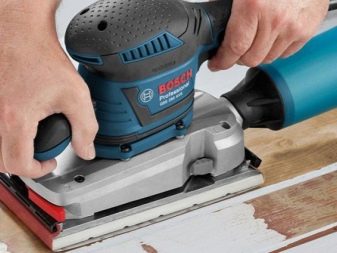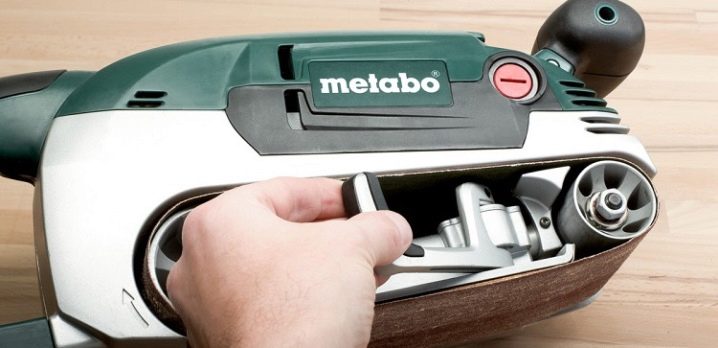Choosing sandpaper for sanding machines

Sometimes situations arise when you need to grind some plane at home, remove the old paint or varnish coating. It is quite difficult to do it by hand, especially with an impressive scale of work.
Taking into account the correct choice of equipment and consumables, you can easily solve a variety of tasks for the processing of all kinds of surfaces.


What it is?
Sandpaper is a flexible abrasive. It is also called a grinding, emery cloth, or simply sandpaper. It is made of a fabric or paper base and a layer of abrasive glued to it. It is intended for grinding surfaces made of brick, concrete, glass, plastic, ideal for working on wood, steel and other surfaces.
Through it you can:
- remove old coating (for example, varnish, paint) and their traces;
- prepare the base for soil and painting;
- remove scuffs and chips from sections of various materials;
- polish, grind, level surfaces.


Consumer characteristics
Most people mistakenly believe that there are 2 types of sandpaper: roll and sheet. But the variety of material is not limited to this. Sandpaper marking tables offer a lot of variations in performance.
- Sanding belt. It is a tightly glued endless belt for installation in scrapers and grinders, units for processing parts. Samples have geometrical parameters specified by the equipment manufacturer.
- Round sandpaper. It is practiced on specialized wheels for a drill or an angle grinder. A velcro surface is used.
- Triangles. They are used in the same way as the round variety. Installed on specialized angle grinders. May have rounded dust extraction holes.
- Roll. A piece of the required length is cut from the coil, which is inserted into the sandpaper holder. It can be either a hand tool or an orbital sander.



How to choose?
For belt sanders
There are some key aspects to consider when choosing sandpaper.
- The size. Without knowing him, making a choice is pointless. The width of the consumable must match the sole. In extreme cases, it can be narrower. For individual modifications, it will not be easy to choose equipment: not every outlet has sandpaper, for example, with dimensions of 100x620 (100x610 is a much more "popular" option) or 30x533. Therefore, you need to take care of this even when buying a grinder.
- Abrasive grain size. It is marked with a number. The larger it is, the softer the sandpaper. It is not hard to understand that the hard consumable is intended for layer removal, not for polishing. Ideally, you should have several belts with different sizes of abrasive, as the sanding procedure is usually carried out in several steps: first, roughing, and then finishing (with a material with a small grain size).


- The seam. Not only the service life of the sandpaper depends on it, but also the quality of grinding. The joint must be strong, otherwise it may turn out that the sandpaper will not wear out yet, but will already lose its functionality due to the breakage. It is also necessary to check the uniformity of the seam. If it is higher than the web, then the unit will vibrate during operation. And that's not the worst part.Regret awaits you when, having processed the plane with low-quality material, you will feel with your hand the countless grooves that have arisen after the jolts. Especially inexpensive consumables sin with this, therefore, it is also necessary to observe savings wisely. It is important to look at the quality of the joint: there should be no protrusion. You just need to run your finger along the back, putting the sandpaper on a flat surface, then everything will be clear.
- Separately, it should be said about the appearance of the edges of the consumable. Solid equipment has smooth edges, no hanging threads.


- Centering. Before work, a knowledgeable user “drives” the grinder without load, finds out if there are any flaws, cancels them, and only then starts the process.
- Rigidity. Exemplary sandpaper must be resilient and strong. Samples with a hard canvas are prone to deformations, which are not the best reflected on the resource of the consumable, which can leave a mark on the quality of work. The markings on the sandpaper and on the product box must match, otherwise you may end up with low-quality equipment.
- Storage. Ideal conditions: temperature 18 ° C and humidity level 50-60%. Abrasives in this matter are quite finicky, in a few months they can become unusable.

For flat (vibration) grinders
Let's talk about consumables for flat grinders. As equipment for surface grinding units, sheets with an abrasive coating, in other words, sandpaper, are used. Compacted paper is often used as the base, and aluminum oxide or corundum is used as an abrasive material. The sheets have holes for dust removal. Their number and location may vary. Therefore, it is important to use exactly the equipment, the holes of which coincide with the holes in the base of the sander.
At times, a stearic coating is used to eliminate the adhesion of sandpaper to the plane and smooth the processing when working with soft wood. Consumables on the sole are fixed either with clamps or by means of adhesive tape. Velcro is a lint-like fabric and is a collection of many hooks. This is a simple and quick way to change the equipment, it may only be difficult to find samples of the appropriate size.



For units with ordinary clamps, it is easier to choose a consumable. There are ready-made sheets in the trade. You can also buy ordinary cuts of abrasive material and make a sandpaper on your own. First you need to cut a sheet of a suitable size. Then perforation should be made either through a home-made device, for example, with a hollow tube of the required diameter with a sharpened end, or through a factory hole punch, which you can buy additionally. There are also grinders on the market that have a replaceable sanding plate. Due to this, the sandpaper can be fixed in different ways.
It is worth noting that sandpaper for grinders is made with different sizes of abrasives. This makes it possible to use the unit for scraping surfaces, grinding, finishing.

Summarizing the above, we can conclude that sandpaper is an ideal material for sanding work. However, in order for the surface treatment to be of high quality, it is worth choosing the most suitable consumables for each specific case.
For information on how to choose sanding paper for a sander, see the next video.













The comment was sent successfully.